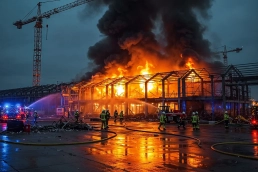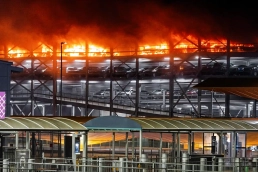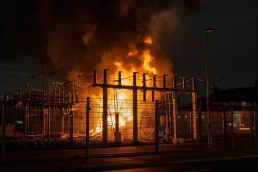Expecting the Unexpected: why fire safety in Airports should never be left to chance
The fire that occurred at the substation serving Heathrow Airport, on March 21 2025, caused massive flight delays and cancellations all over the world; despite the actual cause of the fire is still unknown, experts believe that a lack of automatic fire detectors present at the substation may have been a contributing factor to the amount of damage and delays caused.
Experts believe that if automated fire systems were in place the damage would have been immensely reduced. Substations like the one in Heathrow can be susceptible to numerous types of fire hazards. From the risk of short-circuiting or overheating to leaks in the oil-cooled transformers, project managers must be aware of every possibility and prepare for the worst.
The Risks Present in Airport Construction Sites
When it comes to airports, any kind of disruption can have major repercussions, which is why extensive planning and security measures are crucial. Electrical fires and leaks, which may have caused the Heathrow disaster, are very common hazards on construction sites, and pose an even bigger issue when said sites are located in airports.
Ramtech has had experience in dealing with such environments, having provided WES3 temporary fire devices to aid in the expansion of one of Europe’s biggest major airports. The goal is to expand the airport by 2026 to accommodate over 70 million passengers annually, an increase of 14 million from current levels. This massive expansion includes the construction of a new pier and terminal, operational and commercial spaces, aprons, and taxiways. To handle the increase in passengers, parking capacity will be expanded with landside access to the new terminal.
This major project demanded strict adherence to safety regulations to prevent significant disruptions across the entire airport. To ensure comprehensive coverage, Ramtech provided and installed the WES3 Water Leak Detection System, the WES3 Wireless Fire Alarm System, and the REACT Emergency Notification platform at the airport.


Another significant airport fire incident occurred at London Luton Airport in October 2023, when a fire broke out in a multi-story car park, causing extensive damage and the partial collapse of the structure. The blaze, which affected over 1,200 vehicles, forced the suspension of flights and created major travel disruptions.
Investigations suggested that the fire may have started from a single vehicle before spreading rapidly due to the lack of sufficient fire suppression measures in the car park. This incident highlighted the vulnerability of airport infrastructure to fire hazards and underscored the necessity of stringent fire safety systems in parking facilities as well as operational areas.
The Path Moving Forward
The Heathrow substation fire serves as a stark reminder that fire safety in airports can never be left to chance. Airports are critical hubs of global connectivity, and any disruption, especially one caused by preventable hazards, can have widespread economic and safety consequences.
As demonstrated by Ramtech’s prior experience, implementing proactive fire detection and emergency response systems is essential to mitigating risks and maintaining operational stability. Moving forward, investing in cutting-edge safety technology and stringent regulatory compliance will be key to ensuring that airports remain resilient in the face of unexpected challenges.

Beyond the immediate operational disruptions, incidents like this highlight the importance of infrastructure resilience. Airports must continuously evaluate and upgrade their electrical and fire suppression systems to adapt to new risks, including the growing demand for sustainable energy solutions. A well-maintained and thoroughly inspected infrastructure can significantly reduce the likelihood of catastrophic failures, ensuring passenger safety and minimizing financial losses.
Moreover, collaboration between airport authorities, fire safety experts, and technology providers is crucial in developing robust emergency response strategies. By integrating smart monitoring systems, artificial intelligence-driven risk assessments, and real-time alert mechanisms, airports can stay ahead of potential threats. The Heathrow incident underscores the need for a forward-thinking approach, one that prioritizes innovation, preparedness, and a commitment to safety at every level of airport operations.